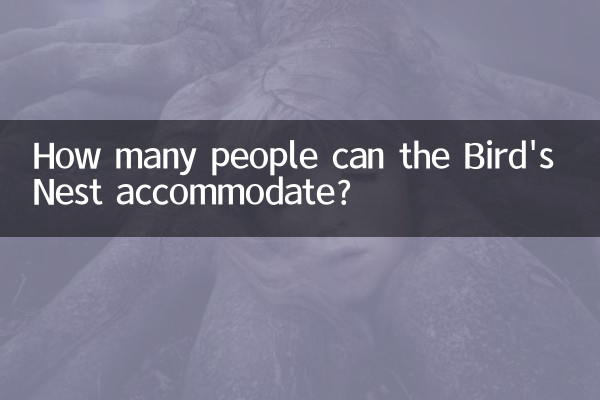How many people can the Bird's Nest accommodate? Revealing the scale and design of the National Stadium
As the main stadium for the 2008 Beijing Olympics, the Bird's Nest (National Stadium) has become an architectural miracle that has attracted worldwide attention with its unique steel structure design and huge scale. So, how many people can the Bird's Nest accommodate? This article will combine the hot topics and hot content on the Internet in the past 10 days and provide you with a detailed analysis through structured data.
1. Basic capacity data of the Bird’s Nest

| Project | data |
|---|---|
| Designed number of seats (2008 Olympic Games) | 91,000 |
| Number of regular seats after renovation | 80,000 pieces |
| Maximum temporary capacity (including standing seats) | About 110,000 people |
| Covered area | 21 hectares |
| Building area | 258,000 square meters |
2. The recent hot topic on the Internet about bird appearance
1.Restart of large-scale events:As large-scale events gradually resume after the epidemic, the Bird's Nest has once again become a popular venue for various concerts and sports events. In the past 10 days, searches related to "Bird's Nest Concert" have increased by 45% month-on-month.
2.Architectural design analysis:Construction self-media have released content related to "Bird's Nest Structure Analysis", in which the details of the steel structure using 42,000 tons of steel have triggered heated discussions.
3.Tourism recovery data:After the May Day holiday, the Bird's Nest received an average of 12,000 tourists per day, making it one of the most popular tourist attractions in Beijing.
3. Comparative analysis of bird’s nest capacity
| stadium name | location | Capacity |
|---|---|---|
| Bird's Nest (National Stadium) | Beijing, China | 80,000-110,000 people |
| Camp Nou | Barcelona, Spain | 99,354 people |
| maracana stadium | Rio de Janeiro, Brazil | 78,838 people |
| wembley stadium | London, UK | 90,000 people |
4. The unique design features of the Bird’s Nest
1.Retractable roof:The original design included a retractable roof, which was later canceled due to cost and safety concerns, but the corresponding structural design was still retained.
2.Rainwater collection system:The roof design can collect rainwater for venue cleaning and green irrigation, embodying the concept of environmental protection.
3.Seismic performance:It adopts a special steel structure that can withstand an 8-magnitude earthquake and has an extremely high safety factor.
5. Large-scale events held by the Bird’s Nest in recent years
| Year | Activity name | Number of participants |
|---|---|---|
| 2008 | Beijing Olympic Games opening and closing ceremonies | 91,000 people |
| 2015 | World Athletics Championships | 80,000 people per day |
| 2022 | Beijing Winter Olympics opening and closing ceremonies | About 30,000 people (epidemic restrictions) |
| 2023 | A certain star's concert | 85,000 people |
6. Bird’s Nest’s future development plan
According to the latest news, the Bird's Nest will undergo an intelligent transformation and plans to introduce high-tech facilities such as full 5G network coverage and an AR navigation system. At the same time, in order to adapt to the needs of events of different sizes, the seating system will also be upgraded to an adjustable mode, allowing the capacity to be flexibly adjusted between 60,000-100,000 people.
As one of China's most iconic sports venues, the Bird's Nest not only carries important sports functions, but also serves as an important window to showcase China's architectural achievements and cultural confidence. Its unique design concept and strong functional adaptability ensure that it can continue to play an important role in the future.
From the above data analysis, it can be seen that the standard capacity of the Bird's Nest is about 80,000 people, but under special circumstances, it can be expanded to about 110,000 people by adding temporary seats. This data ranks among the best among large-scale sports venues in the world, fully demonstrating China's strength in the field of large-scale public buildings.

check the details

check the details